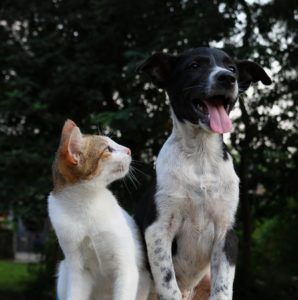Spring cleaning checklist for every pet parent…
Spring cleaning isn’t just for humans anymore! **
________________________________________________________________
Every pet can use some decluttering and organization of his or her life. Here’s the answer…a spring cleaning checklist for every pet parent.
Spring Cleaning Checklist for Every Pet Parent
Deodorize couches, carpets, and pet spaces with baking soda
spring cleaning. Sprinkle baking soda over the carpet and other vacuum-able surfaces to absorb pet odors. Make a ready-to-go mixture using your favorite essential oil –Courtenay from Creek Line House loves peppermint – but make sure your pet approves, too! Fill a saltshaker with baking soda and add a few drops of oil, mixing thoroughly.
After applying to your pets’ bed, let it sit for 10 to 20 minutes. Vacuum thoroughly, using the hose attachments to reach every nook and cranny! In the future, buy a bed with a removable, washable cover; then, only the filling requires deodorizing.
Even the litter box is getting clean today! Add a little more love to that litter box with this spring cleaning checklist for every pet parent.
First of all, get on the gloves. It’s time to scrub that litter box clean! Throw out old litter, thoroughly clean your kitties’ litter box (maybe outside if you can), and then add fresh litter. Things to remember: wash the lid if there’s one, and don’t forget the scooper! Let the box dry thoroughly before putting in the new litter.
Use a damp rubber glove to remove pet hair from the upholstery
For surfaces you can’t vacuum, don a dampened rubber glove to remove pet hair! For large areas, use a rubber squeegee or broom. Run your gloved hand over cushions to collect fur; wad into a tight ball as you go to keep your collection in check.
If it’s your car interior that’s a hairy mess, gently rub a pumice stone over upholstery to remove fur embedded within fibers. A squeegee can also do double duty removing hair and cleaning windows later!
Toss stuffed toys in the washer
spring cleaning! Fido’s favorite teddy is starting to stink, throw in a load of toys! Use an all-natural, unscented detergent, not bleach or Borax; line-dry or on low without a scented dryer sheet, and check for loose parts before returning to its owner. Collars, clothing, blankets, and other fabric-based items are actually to blame for the dreaded “dog smell,” not canines themselves.
Wash each item as directed on its tag. No-tag, no problem! A cold rinse with pet-safe soap can go a long way. Even toys with squeakers and crinkles can make it through the washer unscathed, although let them air dry to be perfectly safe.
An unusual but important point about this spring cleaning checklist for every pet parent. Break out the black light.
Not just for nightclubs, black lights are used to detect urine and other fluids. LED lights are available for any budget and are worth their weight in cleaning products; the longer an accident goes uncleaned, the more damage it does.
Clean with an enzyme-based cleaner – you can DIY and ferment your own all-natural one – to break down any remaining scents; pets often return to the scene of the crime for future infractions. If you’re not the DIY type, Wirecutter recommends BioKleen Bac-Out or Nature’s Miracle.
Plastic bowls and toys can go in the dishwasher
Pet food and water bowls are some of those things that slip our mind to clean – they’re used every day, but not by us. Place plastic pet bowls in the dishwasher for a much-needed rinse; give them another rinse after removal for good measure to remove any traces of detergent.
Heavy-duty rubber toys like the Kong can be placed on the dishwasher’s top-rack, but skip the heated dry setting to avoid potential meltdowns. For stubbornly sticky toys, soak them in a 1:2 vinegar/hot water mixture for 15 minutes. Scrub, rinse, and let dry thoroughly before playtime again.

Pet cleaning tips
Another spring cleaning checklist for every pet parent includes how many tennis balls does your pup really needs? Recycle or donate extra supplies you find.
Speaking of toys…
Whether it’s a handcrafted set of doggie dishes or Fluffy’s millionth rhinestone collar, every pet parent has a forgotten stash of extra stuff. Pare down your pet’s belongings to the essentials, like one or two collars and leashes. And how many catnip mice does kitty really play with?
If you’re planning a garage sale, set out your unopened pet products or gently used equipment! Otherwise, your local animal shelter could put those items to great use. If your pup is a tennis ball fan, look into recycling them as well.
Using the right tools, A must-have hack is included in this spring cleaning checklist for every pet parent…
Another spring cleaning checklist for every pet parent to consider is investing in a vacuum specifically designed for pet hair and dander, which can seriously decrease your chore time. Do your research well, consulting experts like Consumer Reports; not all pet vacuums are created equal, and pricier does not always mean better. Do dirty work like dusting before vacuuming, otherwise, all your hard work will be undone!
Vacuuming hard floorings like wood or laminate will only push around pet hair and other dusty detritus. Save time with a microfiber mop that attracts particles using static cling. Don’t have one on hand? DIY your own with dryer sheets, which operate on the same principle.
Tidying up your pet
Brushing your dog or cat is essential for proper coat maintenance. Long-haired pets need combing regularly to remove any knots or tangles that can potentially become painful mats. A good old-fashioned grooming session at home is not only a great opportunity to bond with your pet, but also to check their skin for any abnormalities like ticks, cuts, scabs, or foxtails. Find the best brush for your dog or cat’s hair length and type, like a soft undercoat or smooth, flat fur.
Particularly fluffy pets should be brushed outside, where extra fur can become one with nature. This keeps fur balls from collecting indoors, which pretty much defeats the point of brushing your pet. If you’re up to the task, try leash training your cat to allow for outdoor grooming.
Spring cleaning checklist for every pet parent-brush their teeth
Plaque and tartar build-up on pets’ teeth, eventually resulting in periodontal disease. As bacteria bloom on the sticky surface of teeth, they expel a foul odor tangible on pets’ breath. Senior dogs and cats, in particular, are prone to bad breath, but a thorough toothbrushing goes a long way!
Between future brushings, use dental dog treats or other pet-safe chewable to prevent plaque from colonizing canines’ canines. Homemade doggie breath mints are a win-win for pet parents and pups – delicious and refreshing.
Don’t forget the collar!
Now’s a great time to clean your pet’s collar too. You can soak it in hot soapy water (lather made with pet shampoo). After about 15 minutes, rinse and let the collar air dry. Keep your pet inside or use a backup collar while cleaning for safety.
Spring cleaning checklist for every pet parent
Food:
Pet food and treats (both wet and dry) can also expire; most have a shelf life of anywhere from four months to several years, depending on its contents and packaging.
Dry Food: As dry food is exposed to air, the nutritional content degrades. Opened bags of dry pet food should be consumed before the expiration date on the package in order for your pet to gain the full nutritional benefits. Never purchase damaged or opened bags of pet food as they could contain unknown contaminants. The quality of the packaging and the amounts of preservatives in the food also affect the shelf life of pet food products. Organic foods have little to no artificial preservatives in them and thus expire faster.
Wet Food: Canned foods last a minimum of one year and can retain nutritional content for up to five if stored properly. However, if a can becomes punctured or rusty or appears to bulge, it should be disposed of as its sterility and seal have been broken.
If you regularly purchase large packages of cat or dog food, consider storing it in an air- and water-tight container instead of the original bag. This can help preserve the food’s nutritional content and extend its shelf life. Make sure you still note the food’s expiration date before throwing out the original bag. Store both canned and bagged pet food in a dry, room temperature location. Bags can mold and cans can rust – both of which may cause health complications.
Spring cleaning checklist for every pet parent-Prescriptions & Medications
Just like food, medications for your cat and dog have expiration dates. Whether they’re in liquid, injectable, or pill form, keep the container they came in; there should be a printed expiration or “use by” date on the package. Environmental factors can also cause the medication to degrade before its expiration date. Any discoloration or changes in consistency and odor are indicators that the medication is no longer viable. While some meds may not show visible signs of degradation, it is important to respect the expiration date to protect your pet’s health.
Administering expired medications to your pet can have dangerous consequences. As the drug ages, the potency and concentration of the medicine decrease. This can lead pet parents to give their pet too little of a drug, which means health problems won’t be resolved. On the flip side, you can also give your pet too high of dosage if you take the reduced potency into account; this can result in an accidental overdose that could be fatal.
There are some guidelines included here in this spring cleaning checklist for every pet parent you should follow when storing your pet’s prescription medications:
Store liquids and injectables out of direct sunlight.
Keep at room temperature or refrigerate as directed.
Avoid high humidity and keep dry.
It may help to mark expiration dates on your calendar or planner or even set up alerts on your phone.
Proper disposal of medications is essential and a critical aspect included in this spring cleaning checklist for every pet parent – do not flush or throw away medications! Your local vet clinic or pet supply store has the proper disposal methods where they will be taken to a biohazards waste dump. Flushing meds can cause them to leach into local groundwater while tossing them can contaminate landfills and local wildlife.
When you’re tackling your own side of the house, be sure to take precautions around potentially deadly substances. Prescription and over-the-counter medications, candy, automotive chemicals, cosmetics, and any small object can all cause a toxic reaction or intestinal obstruction. Keep an eye on garbage cans and bags; put any containing specific poisons directly into your dumpster or curbside can.
What My Members Get!
Join the fun! Grab your free monthly declutter and self-help worksheets and live classes just for my VIP subscribers! Sign-up before the last day of the month or you will miss the worksheets as they are only posted once!
Jump over to the blog and browse the home improvement library. There is something for everyone.
**A special thanks to Colleen Williams, Healthy Paws Newsletter, March 19th, 2019.



